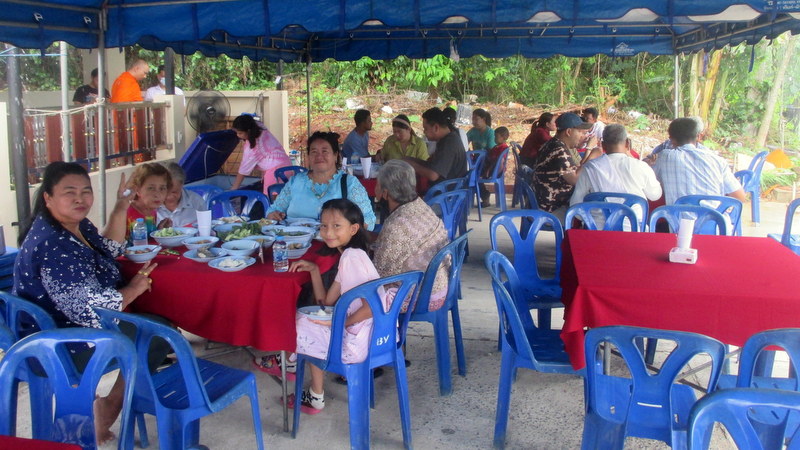In the forecourt, a dozen tables were decked with red cloths and arranged under an awning. Non-stop food and drink. Mountains of rice. Forty kilos of snapper in two huge tureens of fish stew, a sour one made with green pineapples and a sweeter, fragrant concoction. A clear chicken soup with mushrooms and Chinese herbs. Simply delicious.
What was less surprising was the palpable sense of a local community putting on its best face, a celebratory occasion when friends and neighbours might give unstintingly to a respected and popular family. Everyone came bearing gifts: money in sealed envelopes, and items for the new home including a refrigerator, a water heater, no fewer than five electric fans, potted plants and, more in keeping with tradition, a caged singing bulbul, and numerous framed pictures of the usual culprits – His Majesty The King, and a celebrated local monk.
In fact, the Buddhist tradition of blessing a new venture was strictly observed. On a day long before chosen for its auspicious vibrations, five monks had arrived early to intone the chants that sanctify such occasions. These prayers called on the Almighty to bestow good fortune and prosperity on the new dwelling and its occupants, a ‘tum boon baan’ ritual that involved sprinkling lustral water, and binding the home with white string. In return the monks received money and the first lavish breakfast. By eleven o’clock they had gone.
Certain behaviour patterns were discernible to the outsider – and I was the only ‘farang’ ‒ especially unexpected differences between the younger and older generations, and the men and women. Though the party went on all day, with maybe 150 people coming and going, no one seemed to be worse for wear.
Nonetheless, the young bloods, all moustachioed like young Clark Gables, made frequent trips to the huge cooler box that contained the drinks – not to extract a beer as one might expect ‒ but to pour a cloudy , brownish liquid into their insulated mugs. Kratom. Now legal tipple, but a key element in Southern Thai culture and long enjoyed by generations of rural Thais.
A plant from the coffee family, the deeply ribbed leaves are boiled in water to make a kind of concentrated tea. Acting on the same brain centres as opioids, kratom is a mild stimulant and pain reliever. Offered a swig, I noted that the slightly acerbic taste of the infusion had been masked by some kind of sweetener.
Bucking the trend, one table of young men drank ‘Hong Thong’ , a Thai-style rum made with sugar cane molasses. But there was no sign of lao khao, the cheap rice whisky that is standard tipple among indigent rice farmers in the northern provinces.
As for the women, they drank nothing alcoholic apart from the odd beer. And in contrast to their menfolk, none of them smoked. The men, on the other hand, were rarely without a cigarette pressed between their lips – a rather worrying sight – at least to my jaundiced Western eyes. I wondered idly whether such differences in lifestyle might account for the fact that while the men were spare and slim, their partners were mostly ‘pumpui‘. And be-trousered. Hardly a skirt or dress in sight. Phibun would have turned in his grave.
As a Westerner, one is inured to spoilt kids at parties screaming and shouting. What a contrast. Here there were many children, seen but not heard. And they were respectful, happy to wait and serve, fetching and carrying food and drink for their elders.
This might not be a prosperous community, at least by Western standards, but it still observed its time-honoured traditions with both pleasure and pride. Traditions worth preserving.
It was a privilege to be there.
Patrick Campbell’s book ‘The Tropic Gardener’, described in one Bangkok review as the best book on Thai gardening for 50 years, is available for B500 (half price) to personal callers from 59/84 Soi Saiyuan 13 in Rawai (Tel: 076-613227 or 085-7827551).








